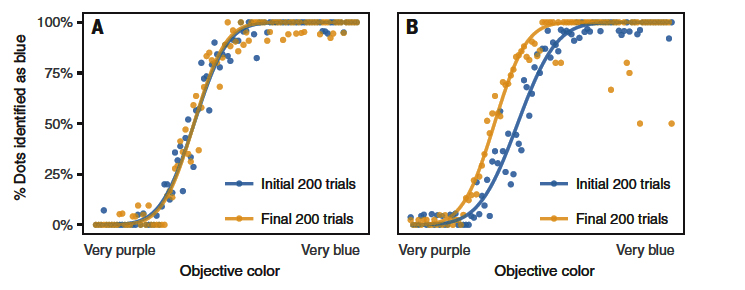Many of us will recognize Daniel Gilbert as a retirement fund spokesman, helping us see just how long our retirement funds will last with dominos, ribbons and sticky notes. But his real job is being a psychology professor, and he has recently co-authored a short but impactful paper in Science on another bias in our judgments. When we describe aspects of the world, big or small, few or many, we compare what we see with some relevant reference value. When we think about how often something occurs, our remembrance of its prior frequency influences our judgment – psychologists term this prevalence-induced concept change. The study reports on seven simple experiments.
The Study
In the first study, people were shown dots of color ranging from very purple to very blue and asked to carefully identify just the blue dots. For the control group, the prevalence of blue dots did not change; for the test subjects, the number of blue dots decreased. Here is the graph of their determinations in both the first and last 200 out of 1000 trials.

In the control group, A, where the frequency of blue dots was constant, identifying ‘true blue’ from other shades of blue did not change. But for those in the test group, B, where there were less ‘true blue’ dots in the later trials, participants began to see other shades like purple as blue too. In essence, as the prevalence of blue dots decreased, the definition of blue expanded. Prevalence affected our judgment. And they demonstrated the same effect when the test subjects were told the prevalence would decrease, or told to be consistent in their decisions and given a monetary reward, and when the prevalence was reduced slowly or abruptly. In fact, they showed the counterfactual, when the prevalence of blue dots increased, the criteria for what was blue narrowed. They repeated the experiment using threatening faces and descriptions of unethical behavior in place of the blue dots and again as the prevalence decreased the criteria expanded so that faces and behavior previously felt to be OK were no longer viewed that way.
Prevalence induced concept change makes us more pessimistic
The implications are huge. It helps explain why despite extraordinary progress in treating disease and alleviating poverty, we still believe a worsening crisis exists. Our pessimism may be rooted in what Dr. Gilbert shows with those blue dots, that our criteria change with prevalence. It helps explain why Hans Rosling’s message in Factfulness, that the world can simultaneously be both better and bad is ignored even when it is true most of the time.
More importantly, the pessimism that the perceptual bias fosters causes us to fail to acknowledge our achievement and to continue arguing in the same strident tones. We continue to fight increasingly divisive battles by expanding our focus to matters that were not of concern a few years ago. In the US, air pollution battles have moved from cars to household products and cosmetics; for smoking, despite a reduction from 42.4% in 1975 to 15.5% last year the media chatter is about vaping. Sometimes we have to take a moment to recalibrate.
Recalibration – an example
The Royal Observatory, located in Greenwich, UK, was established almost 350 years ago and is home to the prime meridian and Greenwich Mean Time two landmarks in the history of time and space. Because of increasing light pollution as well as the pollution of industrialization the observatory closed its door in 1957.
Because the air is far cleaner today, than sixty years ago it will be opening again, telescopes back at work, viewing the blood moon [1] scheduled for July 27th. It is worth taking a moment to enjoy our victories. It is also worth considering whether the bias Dr. Gilbert describes so eloquently is distorting our public conversations.
[1] A blood moon occurs when the full moon passes through the earth’s shadow.
Sources: First, we have to begin with Marginal Revolution, Tyler Cowen’s curation of thoughts and articles blog on economics, but so much more, who pointed me to Dr. Gilbert’s work. That took me to his paper, Prevalence-induced Concept Change in Human Judgment published in Science DOI: 10.1126/science.aap8731. The notes on the Royal Observatory come from Atlas Obscura.




